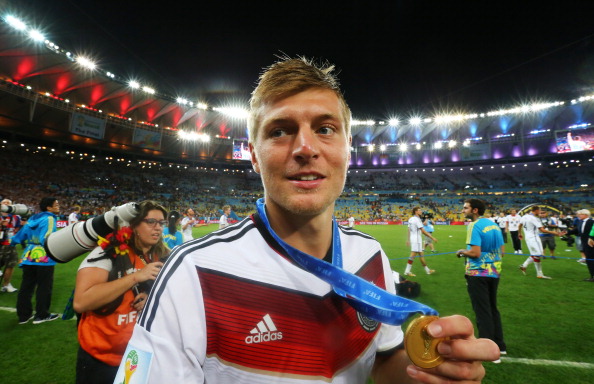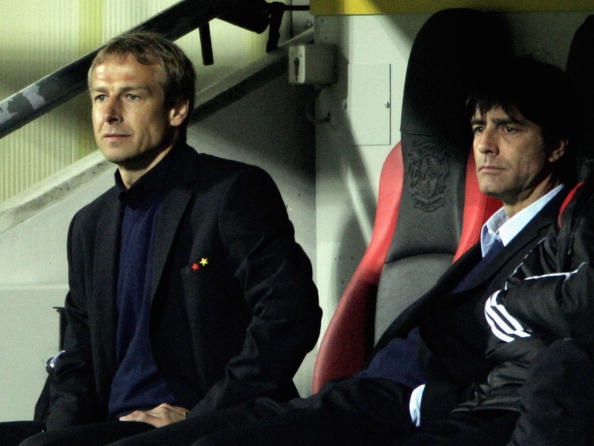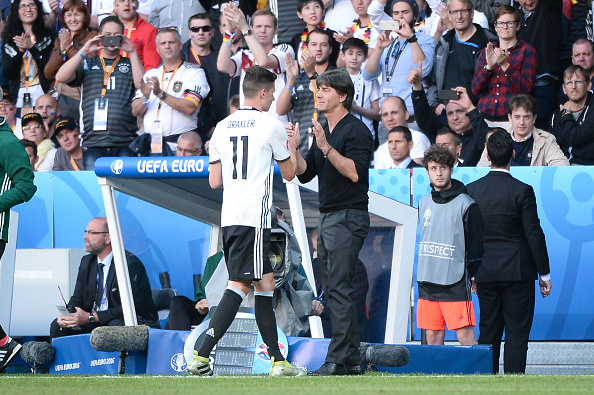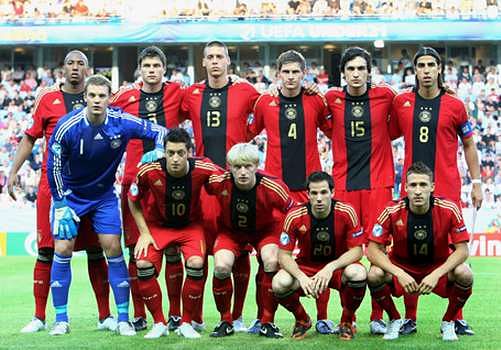
The golden fruit of the German youth system - Toni Kroos

Toni Kroos turned 27 on January the 4th, 2017 and while he may have a good number of playing days left, his trophy collection is a handsome one already. The mercurial midfielder has notched up 3 Bundesliga titles and a Champions League with Bayern Munich and another Champions League Trophy with his current club Real Madrid.
While it may be a bit premature to deem him a legend, everyone in the football fraternity will readily admit that he is world class and has indeed been so for a few years now. As far as his successes are concerned, his World Cup triumph with Germany in 2014 is one that has to be mentioned separately for it was a victory that was the perfect testament to the success of the German youth system.
The backbone that was missing for years
The German team of today is filled with formidable superstars and it is difficult to imagine a major tournament in which the nation does not do well. In the six major tournaments they have participated in since 2006, they have at least made it to the final four in all six instances.
Such was not the case over a decade ago when German football was in dire need of a renaissance. Following their World Cup win in 1990, Germany crashed out in the quarter-finals of the subsequent World Cups as they succumbed to a 1-2 defeat to Bulgaria in 1994 and a thumping 3-0 defeat at the hands of Croatia in 1998 and failed to progress from the group stages in the 2000 Euros.
Wolfgang Niersbach, former president of the German Football Association, spoke before the World Cup about how Germany saw that a change was needed and that the talented youth needed to be nurtured better. Strength and commitment had been enough to get the Germans through many tournaments previously but other teams had evolved and they realised that they needed to have more technically adept players to succeed.
Germany strived to harvest what it had on its doorstep. Since the year 2000, 366 training centres were set up and around 1000 coaches were employed to ensure that almost all young and promising talent was ensnared and moulded. Better training facilities were now available to children aged between 8 and 14. Their success has been due to the cooperation between the regional amateur associations and their local professional clubs.
Cometh Klinsmann, cometh change
Joachim Low and Oliver Bierhoff speak very fondly of Jurgen Klinsmann. Germany’s leader in their 1996 European Championship triumph, he had captained a unified Germany to their first piece of international silverware. Yet, that victory was shrouding the decline that the nation’s football scene was undergoing.
The journey of a thousand miles may begin with a single step, but a single step or two don’t cover it. The onus had been taken by the federation to set up better training facilities and scout the best that there available. But a head coach was needed to bring out a change within the national team.
Jurgen Klinsmann was the man who took charge in 2004 and Bierhoff attributes a major part of Germany's success to Klinsmann. He may have been present for only 2 years, but he had the fortitude to spice things up, play a much more fast paced game and integrate younger players into the team.

With the arrival of Klinsmann, the whole environment of the national team changed and an air of professionalism took over. Full-time coaches were employed and a full-time sports psychologist as well. Various fitness coaches helped the cause as well.
The tree that was the German youth system started yielding fruit from as early as 2010 in South Africa where Germany saw many youngsters in their early twenties such as Mesut Ozil, Thomas Muller and Sami Khedira break into the first team. They finished third in the end, but people noticed the outfit that had annihilated England 4-1 in the round of 16 and a Maradona-managed Argentina 4-0 in the quarter-finals.
It might be worth noting that the German U-17 team, in 2007, won 4-1 against the English U-17 in the quarter-finals of the FIFA U-17 World Cup, so perhaps that was the first indicator of future glory. If not that, then the triumph of Germany in the U-21 European Championships in 2009 certainly was. The team was captained by Khedira (but surprisingly did not involve Kroos).
The Löws and highs
Löw, who was the assistant to Klinsmann initially, took over in 2006 following the World Cup and Germany have never looked back since. Young players have continued to flourish in the German national team setup and post their 2014 triumph, Löw described his team as a group of grounded individuals who were always motivated for victory; almost bred for it in fact.
Germany may have lost in the semi-finals of the 2016 European Championships, but their excellent track record still remains a thing of envy in the international football community and the Euros in France also saw the coming of age of Draxler and Kimmich.
Kimmich performed his role as right-back very well; a position which had been vacated by Lahm who retired from international football in 2014. If a gaping hole as large as the one left by Lahm can be filled reasonably enough by a homegrown 21-year-old, then the nation can breathe easy.

How youth academies have worked wonders elsewhere
As far as international glory goes, it is a near impossible task to replicate the Spanish team which won the World Cup in 2010 sandwiched between 2 European triumphs in 2008 and 2012. The core of the Spanish team consisted of a fair number of graduates from the Barcelona youth academy, La Masia.
The likes of Xavi, Iniesta, Busquets, Puyol and many others were part of a vastly successful Barcelona side. In fact, the side which Spain fielded in the 2010 World Cup final consisted of 7 players from La Masia, out of which 6 started the match.

While La Masia has given unprecedented benefit to Spain, the Ajax youth academy has produced some great gems as well. The likes of Cruyff and Van Basten come to mind, who have taken Dutch football to great heights indeed.
Some lessons to learn
A contrast to Germany’s amazing performances in the recent years would be England’s. England seem to always punch below their weight and disappoint fans by exiting a tournament earlier than expected. While many of their failures have been attributed to players underperforming on the night, poor tactics by managers or even sheer bad luck, they could certainly use a better youth setup.

The cohesion that exists in Germany between the clubs and the German Football Association is difficult to replicate in England where there is a lot of infighting between the English Football Association and the Premier League. No single body in control of youth development in England exists because of these quarrels and the Professional Game Development Youth Group, which was one such singular body, ceased to exist after only 1 year of existence.
The likes of Dele Alli and Eric Dier are certainly diamonds in the rough, but many more young guns need to be nurtured to help bring glory to the nation.
What are your thoughts on the German youth system and the role of youth in the success of football in general? Let us know via this poll.
